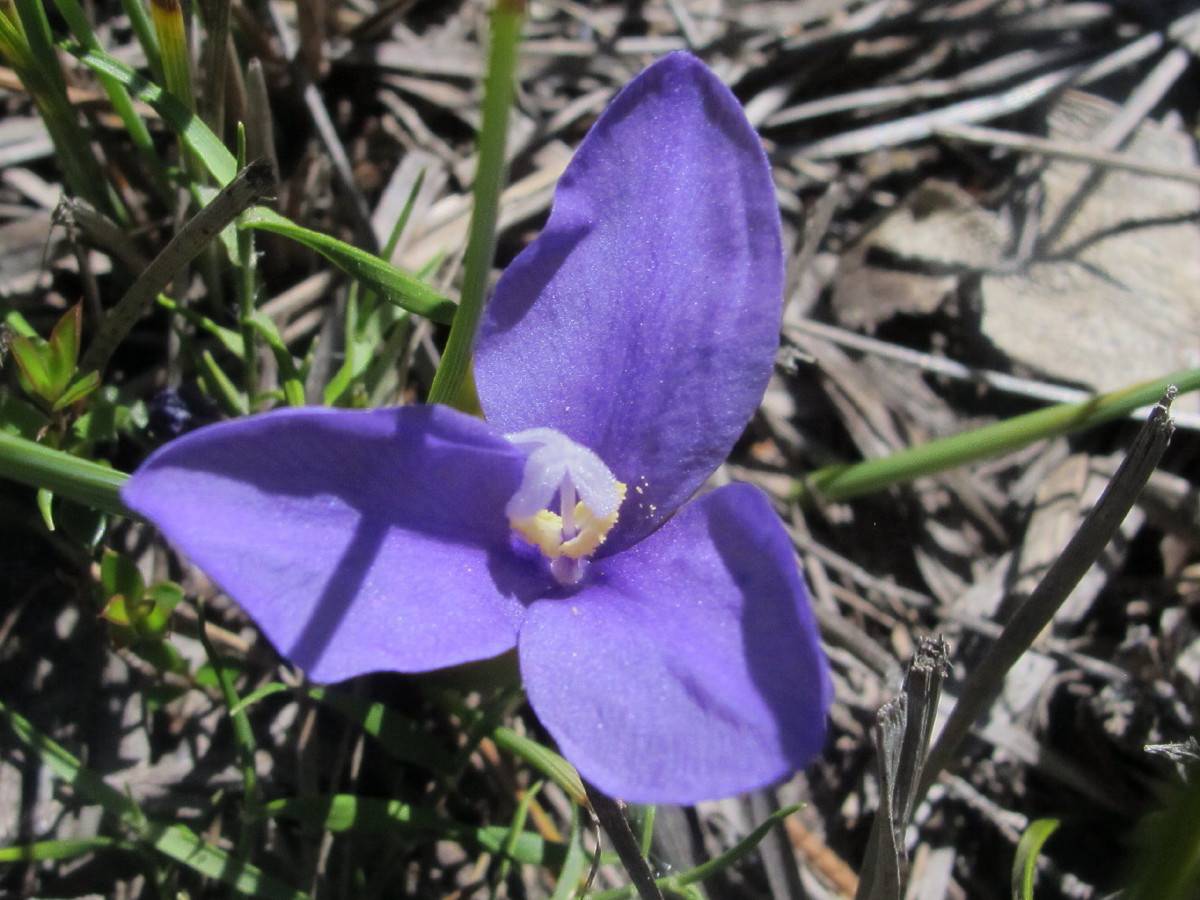Spring M-P
Viewing the meaning of botanical words To view the meaning of botanical words, hold the cursor on the blue word and the meaning will appear in a text box.
Based on Debenham C’s, The Language of Botany, A Publication of The Society for Growing Australian Plants, Chipping Norton NSW, c.1962.
Patersonia fragilis
Botanical Name: Patersonia fragilis
Commonly Called: Short purpleflag
Botanical Family: Iridaceae
Grows: The clumps grow 10 to 40cm high by 30 to 40cm wide
Foliage: The firm leaves are narrow, sheathing, ridged and linear. They are dull green/blue to green, 20 to 40cm long.
Flowers: The flowers have 3 conspicuous rounded blue/mauve perianth segments, enclosed in brown terminal bracts on stems shorter than the leaves.
Flowering Season: Flowers appear in late spring and into summer.
Fruit: The fruit is a 3-celled capsule.
Habitat/distribution: The beautiful small clumping plant is found in moist coastal heaths. It also grows in SA, Vic and NSW.
Where found: Strahan, Queenstown, Birchs River Plains and many other places in the west; King, Three Hummock, Furneaux and Bruny Islands; Georgetown, Bridport, St Helens area and many locations in the north east; Freycinet, Forrestier and Tasman Peninsulas and near Orford; Lindisfarne, Longley, near Geeveston, near Hastings Caves and many other places in the south east; Heritage Forest Tasmanian Native Garden; Royal Tasmanian Botanical Gardens; Tasmanian Bushland Garden, Buckland; and The Tasmanian Arboretum, Eugenana; also many home gardens.
Other notes: Can be differentiated from P. occidentalis by its smaller growth habit, with narrower leaves and flower stems shorter than the leaves. The flower bracts contain many flowers that each last about one day. Grow in well drained moist soil in full sun.
Pimelea drupacea
Botanical Name: Pimelea drupacea
Commonly Called: Cherry riceflower
Botanical Family: Thymelaeaceae
Grows: An open shrub growing 1 to 3m high by 0.5 to 1m wide.
Foliage: The leaves are arranged in pairs, elliptical in shape, green upper surface, slightly hairy undersurface with prominent veins.
Flowers: The small white/cream terminal flower clusters which may appear to be axillary because of the shortness of branchlet, have 2 leaf-like bracts and 2 central orange stamens. As the flowers mature they tend to develop a pink throat.
Flowering Season: The flowers appear in late spring.
Fruit: The fruit matures from reddish to a shiny ovoid black drupe.
Habitat/distribution: This shrub is widespread and common as understorey in wet sclerophyll forests. It is also found in Victoria
Where found: Wide spread in wet sclerophyll; throughout the south west, west, north west, north east and south east; Maria, Bruny and Bass Strait Islands; Cradle Mountain and Lake St Claire, Hartz Mountain and Tasman NPs; Wellington Park; Richardsons Road near High Yellow Bluff and MacGregor Road, Forestier Peninsula.
Other notes: Black shiny, ovoid fruit on plant in wet forests. A hardy plant for moist locations in part shade to full sun. Tip pruning after fruiting enhances the plant. The black shiny fruit attracts birds.
- Acacia dealbata Sp
- Acacia genistifolia Sp
- Acacia gunnii Sp[
- Acacia leprosa Sp
- Acacia melanoxylon Sp
- Acacia verticillata Sp
- Aotus ericoides Sp
- Brachyscome spathulata Sp
- Bulbine glauca Sp
- Chamaescilla corymbosa Sp
- Chrysocephalum apiculatum Sp
- Comesperma volubile Sp
- Daviesia latifolia Sp
- Diplarrena moraea Sp
- Epacris impressa Sp
- Goodenia elongata Sp
- Goodenia lanata Sp
- Goodenia ovata Sp
- Goodia lotifolia Sp
- Hardenbergia violacea Sp
- Hibbertia appressa Sp
- Hibbertia procumbens Sp
- Hibbertia riparia Sp
- Hibbertia sericea Sp var sericea
- Patersonia fragilis Sp
- Pimelea drupacea Sp
- Stackhousia monogyna Sp
- Zieria arborescens Sp
- Blackwood Sp
- Blue lovecreeper Sp
- Blue stars Sp
- Bluish bulbine-lily Sp
- Cherry riceflower Sp
- Common Everlasting Sp
- Common heath Sp
- Erect guineaflower Sp
- Forest candles Sp
- Golden pea Sp
- Hop bitterpea Sp
- Hop native-primrose Sp
- Lanky native-primrose Sp
- Ploughshare wattle Sp
- Prickly moses Sp
- Purple coral-pea Sp
- Short purpleflag Sp
- Silky guineaflower Sp
- Silver wattle Sp
- Smooth goldentip Sp
- Southern guineaflower Sp
- Spoonleaf daisy Sp
- Spreading guineaflower Sp
- Spreading wattle Sp
- Stinkwood Sp
- Trailing native-primrose Sp
- Varnish wattle Sp
- White flag-iris Sp


